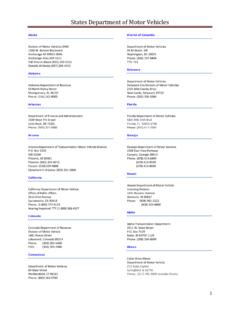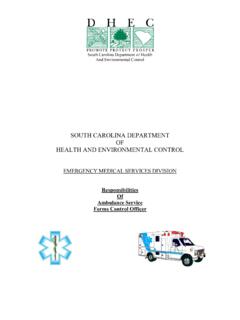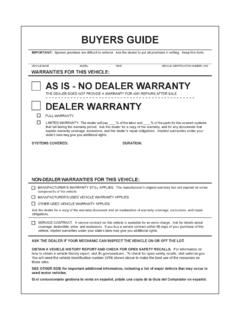Transcription of Motor Vehicle Safety Defects And Recalls
1 Motor Vehicle Safety Defects And Recalls What Every Vehicle Owner Should Know I. Motor Vehicle Safety Defects and Recalls II. Table of Contents Introduction .. 1. Purpose .. 2. Frequently Asked Questions on Recalls .. 2. When Is a recall Necessary? .. 2. What Is a Safety -Related Defect? .. 2. Examples of Defects Considered Safety -Related .. 3. Examples of Defects Not Considered Safety -Related .. 4. How Can I Report a Safety Problem to NHTSA? .. 4. How Will My Report Be Used? .. 5. Will I Be Contacted? .. 7. How Many Reports Must Be Filed Before NHTSA. Investigates an Issue? .. 7. How Does NHTSA Conduct an Investigation? .. 8. What Happens When NHTSA Determines a Safety Defect Exists? .. 10. If NHTSA Makes a Final Decision, Can the Manufacturer Challenge That Decision?
2 10. Do Manufacturers Ever Initiate Recalls Without a Government Order? .. 11. How Will I Be Notified If a recall Is Ordered or Initiated? .. 11. How Are Problems With Recalled Vehicles or Equipment Remedied? .. 12. If I Pay for Needed Repairs Before a recall Is Ordered, Am I Entitled to Reimbursement? .. 12. Are There Any Limitations to My Right to Have a Recalled Vehicle Remedied at No Charge? .. 13. What About Tire Recalls ? .. 13. What If a Dealer Denies My Right to Have a Recalled Vehicle Remedied at No Charge? .. 14. Once a recall Is Initiated, Can I Take Independent Legal Action for Injuries I May Have Suffered? .. 14. Where Can I Find Additional Resources on Recalls and Other Vehicle Safety Issues? .. 15. III. Motor Vehicle Safety Defects and Recalls IV. Introduction In 2015, approximately 35,092 lives were lost on our Nation's highways.
3 Although that number represents a decrease in traffic fatalities since 2006, more can still be done to address this issue on our Nation's highways. Traffic crashes are the primary cause of debilitating injuries in the United States and the number one killer of Americans 11 years old and those 16 to 24. In addition to staggering emotional costs, the annual economic loss to society because of these crashes, in terms of worker productivity, medical costs, insurance costs, etc., is estimated at more than $230 billion. Clearly, there is a need for dramatic improvement in Motor Vehicle Safety . Getting unsafe vehicles off the road is integral to improving Safety and saving lives. The National Traffic and Motor Vehicle Safety Act gives NHTSA the authority to issue Vehicle Safety standards and to require manufacturers to recall vehicles that have Safety -related Defects or do not meet Federal Safety standards.
4 Since the Act was enacted in 1966, NHTSA has recalled more than 390 million cars, trucks, buses, recreational vehicles, motorcycles, and mopeds, as well as 46 million tires, 66 million pieces of Motor Vehicle equipment, and 42 million car seats due to Safety Defects . Manufacturers voluntarily initiate many of these Recalls , while others are either influenced by NHTSA investigations or ordered by NHTSA via the courts. If a Safety defect is discovered, the manufacturer must notify NHTSA, as well as Vehicle or equipment owners, dealers, and distributors. The manufacturer is then required to remedy the problem at no charge to the owner. NHTSA is responsible for monitoring the manufacturer's corrective action to ensure successful completion of the recall campaign. 1. Motor Vehicle Safety Defects and Recalls Purpose The purpose of this booklet is to answer the most commonly asked questions about how and why recall campaigns are initiated, and to inform consumers of their rights and responsibilities when a Vehicle or item of Motor Vehicle equipment is recalled.
5 In these pages, you'll discover how to report a Safety -related problem to NHTSA, as well as how participation by Vehicle owners like you helps to keep Motor vehicles as safe as possible. See the following section for comprehensive answers to some of the most frequently asked questions (FAQs) NHTSA receives on Recalls . Frequently Asked Questions on Recalls When Is a recall Necessary? When a Motor Vehicle or item of Motor Vehicle equipment (including tires). does not comply with a Federal Motor Vehicle Safety Standard. When there is a Safety -related defect in the Vehicle or equipment. Federal Motor Vehicle Safety Standards set minimum performance requirements for those parts of the Vehicle that most affect its safe operation (brakes, tires, lighting, etc.) or that protect drivers and passengers from death or serious injury in the event of a crash (air bags, seat belts, car seats and booster seats, energy absorbing steering columns, motorcycle helmets, etc.)
6 These Federal Standards are applicable to all vehicles and Vehicle -related equipment manufactured or imported for sale in the United States (including territories) and certified for use on public roads and highways. What Is a Safety -Related Defect? The United States Code for Motor Vehicle Safety (Title 49, Chapter 301). defines Motor Vehicle Safety as the performance of a Motor Vehicle or Motor Vehicle equipment in a way that protects the public against unreasonable risk of accidents occurring because of the design, construction, or performance of a Motor Vehicle , and against unreasonable risk of death or injury in an accident, and includes nonoperational Safety of a Motor Vehicle . A defect includes any defect in performance, 2. construction, a component, or material of a Motor Vehicle or Motor Vehicle equipment.
7 Generally, a Safety defect is defined as a problem that exists in a Motor Vehicle or item of Motor Vehicle equipment that: poses an unreasonable risk to Motor Vehicle Safety , and may exist in a group of vehicles of the same design or manufacture, or items of equipment of the same type and manufacture. Examples of Defects Considered Safety -Related Steering components that break suddenly, causing partial or complete loss of Vehicle control Problems with fuel system components, particularly in their susceptibility to crash damage, which result in leakage of fuel and may cause Vehicle fires Accelerator controls that break or stick Wheels that crack or break, which may result in loss of Vehicle control Engine cooling fan blades that break unexpectedly, causing injury to people working on a Vehicle Windshield wiper assemblies that fail to operate properly Seats and/or seat backs that fail unexpectedly during normal use Critical Vehicle components that break, fall apart, or separate from the Vehicle .
8 Causing potential loss of Vehicle control or injury to people inside or outside the Vehicle Wiring system problems that result in a fire or loss of lighting Car ramps or jacks that may collapse and cause injury to someone working on a Vehicle Air bags that deploy under conditions for which they are not intended to deploy Car seats and booster seats that contain defective Safety belts, buckles, or components that create a risk of injury not only in a Vehicle crash, but also in the nonoperational Safety of a Motor Vehicle 3. Motor Vehicle Safety Defects and Recalls Examples of Defects Not Considered Safety -Related Air conditioners and radios that do not operate properly Ordinary wear of equipment that has to be inspected, maintained, and replaced periodically ( , shock absorbers, batteries, brake pads and shoes, and exhaust systems).
9 Nonstructural or body panel rust Quality of paint or cosmetic blemishes Excessive oil consumption How Can I Report a Safety Problem to NHTSA? If you think your Vehicle or equipment may have a Safety defect, reporting it to NHTSA is an important first step to take to get the situation remedied and make our roads safer. If the agency receives similar reports from a number of people about the same product, this could indicate that a Safety -related defect exists that would warrant the opening of an investigation. In order to make it convenient for consumers to report any suspected Safety Defects to NHTSA, the agency offers two ways to file such complaints. Vehicle Safety Hotline NHTSA operates the Department of Transportation's (DOT) Vehicle Safety Hotline to collect accurate and timely information from consumers on Vehicle Safety problems.
10 Call 888-327-4236 or 800-424-9393 toll-free from anywhere in the United States, Puerto Rico, and the Virgin Islands to register complaints or receive recall information about a Vehicle . The Hotline also has Spanish-speaking representatives and offers a dedicated number, 800-424-9153, for use by people who are deaf or hard of hearing. When you call the Hotline to report a Vehicle -related Safety issue, you will be asked to provide certain critical information that agency technical staff needs in order to evaluate the problem. The information you provide is filed on a Vehicle Owner's Questionnaire (VOQ), entered into the agency's consumer-complaint database, and forwarded to NHTSA technical staff for evaluation. 4. VOQs filed through the Hotline will be mailed to you for verification of data.










